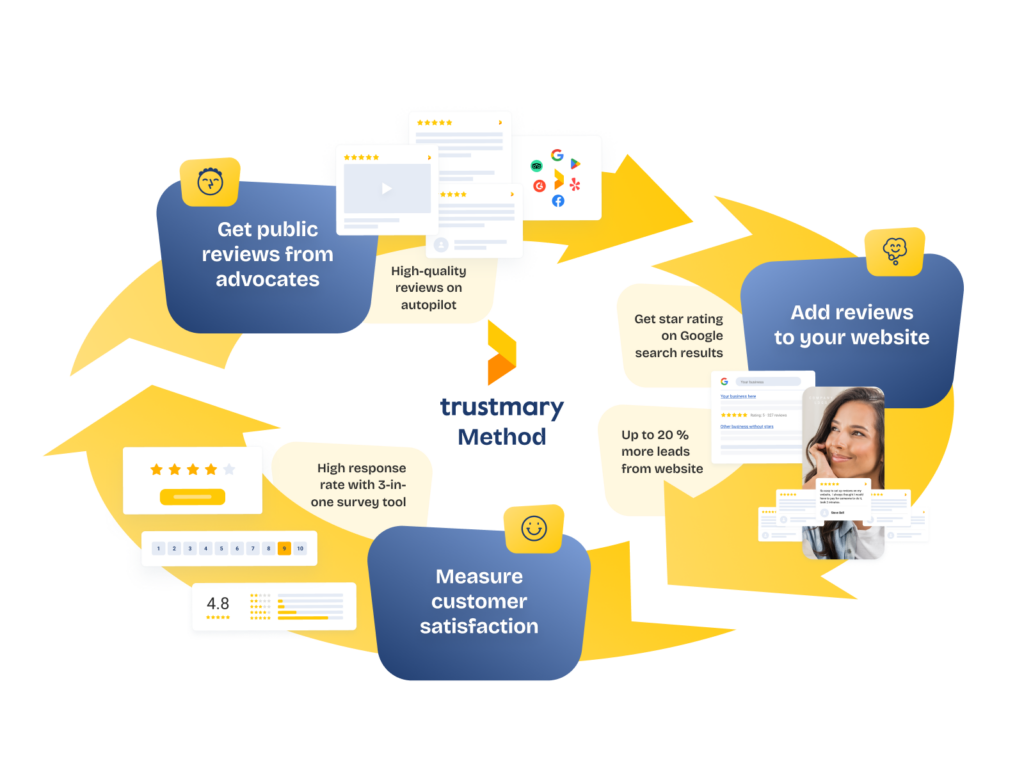How Can A Customer Feedback Loop Help Your Business?


You know that customer feedback is important. It lets you in on what your customers think and want.
But did you know that an effective customer feedback system can do much more?
This blog introduces you to the concept of customer feedback loops and how they help your business grow.
What Is A Customer Feedback Loop?
A customer feedback loop is a continuous process that you execute to collect customer feedback and reviews, which are turned into customer insights by analyzing them.
It’s also a strategic framework that models the stages of customer feedback management.
A solid customer feedback loop ensures that you collect and manage feedback effectively.
As a result, you create better customer experiences.
When you google “customer feedback loop”, you get various answers. That’s because different businesses and organizations use different methods in their customer feedback programs.
The key is finding the best customer feedback loop for your business.
Although the model itself can vary quite a bit, the principle is always the same: you get feedback, react to it, and get feedback again.
What Does “Closing The Loop” Mean?
You have probably encountered the phrase “closing the loop” in customer feedback.
What does it actually mean? What is a loop and how does one close it?
The problem with most businesses is that they are collecting feedback from customers, but not making use of it.
Customers are unsure whether their feedback matters, and don’t even bother to provide their input.
Closing the loop refers to communicating with the customers about how their feedback is used.
It’s not just a general “Thanks for your feedback, we truly appreciate it!” at the end of a feedback survey.
It’s things like actual improvements, transparency on feedback reports, and publishing customer feedback.
These actions let your customers know that their feedback matters.
Closing the loop is important, as it increases customer satisfaction and customer loyalty.
The below chart shows one example of a closed feedback loop.
Different Customer Feedback Loops
Now, let’s inspect three different feedback loops.
Each model conveys almost the same outcome, but they are illustrated in different ways.
The A.C.A.F Customer Feedback Loop
One of the most used models of feedback collection is the 4-step A.C.A.F loop.
The A.C.A.F customer feedback loop comes from the words:
- Ask
- Categorize
- Act
- Follow-up
Let’s break down the steps.
1. Ask
Asking for feedback sounds simple, but you must be careful when choosing the right customer feedback question(s).
Consider the following aspects:
- What do I want to get feedback on?
- Am I targeting the overall experience or a specific touchpoint?
- What is the best format for asking for feedback in my case?
- What is the right time to send a feedback survey?
- How can I convince my customers to give me feedback?
- Do I need quantitative or qualitative feedback? Or both?
Other critical factors in defining feedback points are considering the channel and the timing.
2. Categorize
How can you stay on top of the situation and keep track of the responses when you get feedback?
Quantitative feedback is easy to track, but it doesn’t tell you much about what customers expect you to do next.
Qualitative feedback, on the other hand, is difficult to measure and keep track of, but it reveals valuable information that you don’t want to dismiss.
You might want to categorize the qualitative feedback into different themes. It helps you discover the most frequent requests and pain points.
Prioritize the feedback according to the most urgent issues and your resources at the moment.
3. Act
Once you have categorized and prioritized the feedback, it’s time to act.
Share the feedback results with your colleagues. Come up with an action plan, and start fixing the most urgent issues.
There are various ways to organize this, starting from a simple spreadsheet, and spanning to dedicated tools like Productboard.
4. Follow-up
In the last phase, you should let the customers know that you did something about their feedback.
This does not mean that you have to contact each one personally. You can, if that’s within your resources, but it’s enough to report the changes through a newsletter, for example.
When the whole customer base knows you act on the customer feedback, maybe they will be more likely to take part in your next survey.
Additionally, this strategy will increase customer loyalty! Customers will happily stay with a company that is developing in the right direction.
The 5-Step Customer Feedback Loop
Another model that you are likely to encounter consists of 5 steps:
- Gather customer feedback
- Learn and analyze
- Acknowledge and respond
- Make changes
- Close the loop (follow up)
Despite the steps looking different, the process is largely the same.
There’s one crucial difference between asking for feedback and gathering feedback.
When you think of feedback as something that you can only “ask for”, you might ignore some important types of customer feedback.
You might also get unsolicited feedback in the form of customer complaints, social media comments, or discussions with the customer support team.
Don’t forget to consider all your customer feedback.
The 3-Step Loop from Customer Feedback to Customer-Led Growth
Most feedback loops concentrate on negative feedback and processes on how to handle difficult customers.
Constructive feedback indeed is what helps you develop the product or service and create better experiences. By embracing constructive criticism, you can learn to see things from your customers' point of view.
However, positive feedback is just as important.
Ask your happy customers to give their feedback publicly. It’s also a form of closing the loop. It will make your satisfied customers feel valued.
When you have positive customer stories to showcase, you're more likely to get new customers.
We like to call this one the feedback flywheel, as it’s more than just a loop. It’s a driving force.
In flywheel thinking, the customer feedback loop turns into a machine that grows your business. Each completed loop means a step in the right direction.
The flywheel includes three steps:
- Gathering Feedback
- Gathering Testimonials
- Utilizing Testimonials

1. Collect Customer Feedback
The Trustmary-style feedback loop starts with a Net Promoter Score (NPS) survey.
In an NPS survey, you ask your customers the following question:
“How likely are you to recommend [company name] to a friend or colleague?”
The customer answers on a scale from 0 to 10. According to their answers, the customers are divided into three groups:
- Promoters (satisfied and loyal customers who are willing to recommend)
- Passives (somewhat happy, but not loyal customers)
- Detractors (unhappy customers who are likely to churn or spread bad word-of-mouth)
Next, they are asked to elaborate on why they gave the score:
“What is the primary reason for choosing this score?”
The answer to this open-ended question helps you identify improvement points and possible issues in the customer journey.
By using NPS, you get both quantitative and qualitative feedback.
To find the right NPS question to ask, see variations of the NPS question.
2. Gather Testimonials
Testimonials are the stories of your happy customers. They highlight the positive experiences, and how your product or service has helped your customers.
Testimonials are positive reviews.
How are they connected to NPS?
When you conduct an NPS survey, you get to identify the customers that are willing to recommend your business.
Why not let them do so?
Trustmary asks your Promoters (people who gave a Net Promoter Score of 9 or 10) to submit their feedback publicly.
It collects your customers’ consent to publish their stories online.
3. Utilize Testimonials
Lastly, Trustmary highlights the customer testimonials on your website using stylish widgets.
This boosts your website conversion rate and gets you more clients!
The effectiveness of testimonials is based on social proof.
When your new potential customers see that numerous happy customers have positive experiences with your brand, they are more likely to trust you.
After completing the whole loop, you have used your feedback system to generate more customers, who in turn will provide you with more feedback and testimonials.
Isn’t that great?
Get Reviews That Matter with A Feedback Loop
If you don’t have an effective customer feedback loop in place, you will miss out on constructive feedback and identifying your loyal customers.
When you do have a strong customer feedback strategy, you can grow like crazy.
It requires not only collecting feedback but also making use of it and closing the customer feedback loop.
The short recipe for success is:
- Regular NPS surveys at the right time.
- Add HTML feedback form to website for quick feedback on website helpfulness
- Identifying your satisfied customers and asking for their public feedback.
- Utilizing customer testimonials in your marketing efforts.
- Learning from the constructive feedback your customers give you.
- Following up with your customers after they give you feedback, and informing them about changes you are going to implement.
When you gather customer feedback, you are not only developing the customer experience. You are also creating positive social proof that you can leverage in marketing.
| Get Insights | Improve CX | Close The Loop | Get New Customers | |
| 5-Step | ✅ | ✅ | ✅ | ❌ |
| A.C.A.F | ✅ | ✅ | ✅ | ❌ |
| 3-Step | ✅ | ✅ | ✅ | ✅ |
You are solving key pain points across your organization:
- Salespeople can use customer testimonials as a persuasive asset in the sales process.
- The marketing team can boost the website conversion rate by displaying customer testimonials.
- The Customer Success team learns invaluable lessons from the customer feedback and gets to build even stronger relationships with loyal customers.
- You can provide a better customer experience overall.
When the process is refined, your flywheel will roll on its own and turn strangers into prospects into customers into promoters who eventually get more strangers interested in your business.
The best thing is that with the right tool, you can largely automate the process.
Come and take a quick chat with us by clicking on the link below!
Further Reading
FAQ
What is a customer feedback loop?
A customer feedback loop is a model or strategic framework that describes the feedback collection and management process. The “loop” comes from the idea that it is a continuous process.
Why is a customer feedback loop important?
When you have a functional customer feedback loop in place, you can grow your business by doing the following things: learning from customer feedback, leveraging positive feedback in marketing, and creating customer loyalty by closing the feedback loop.